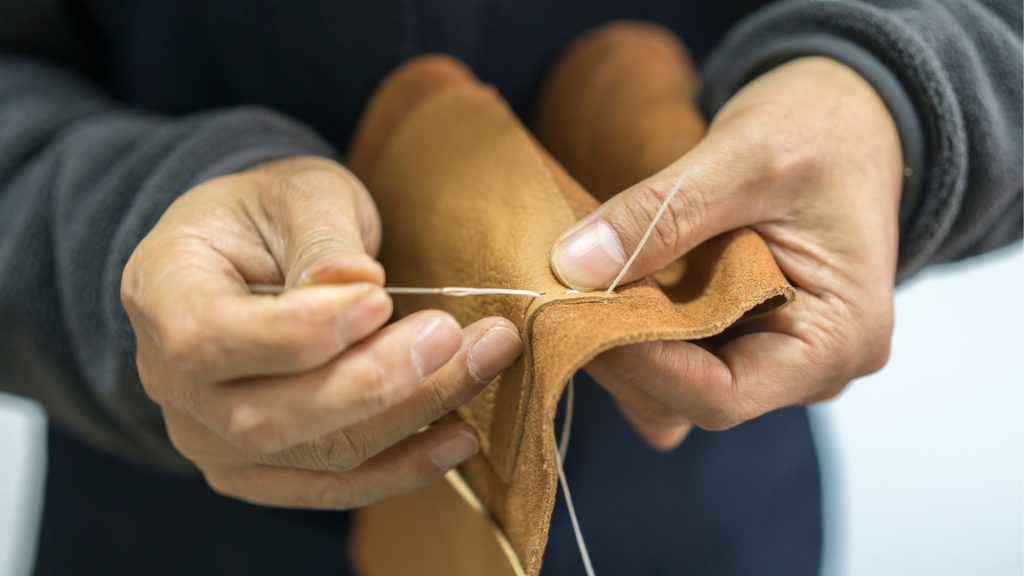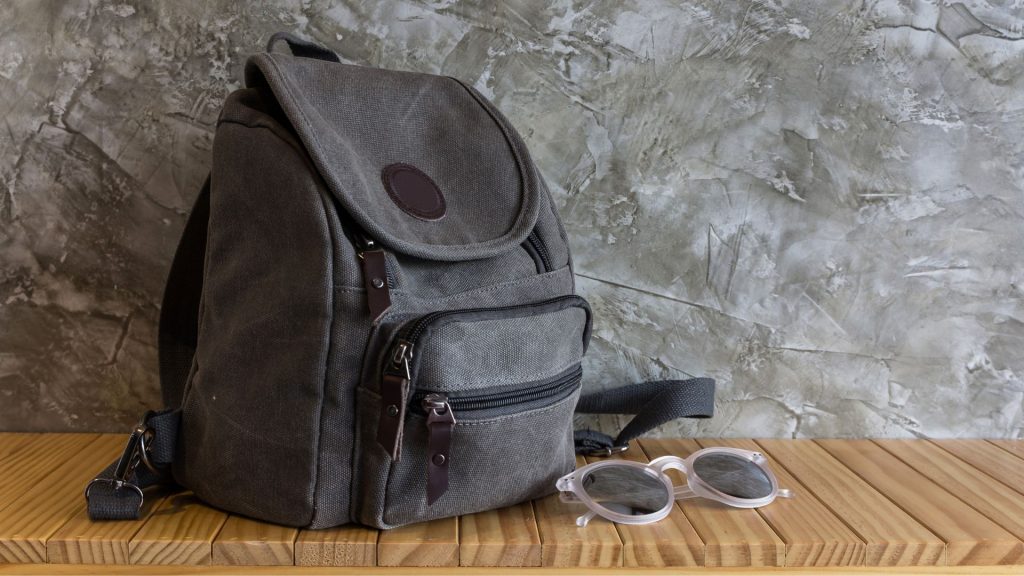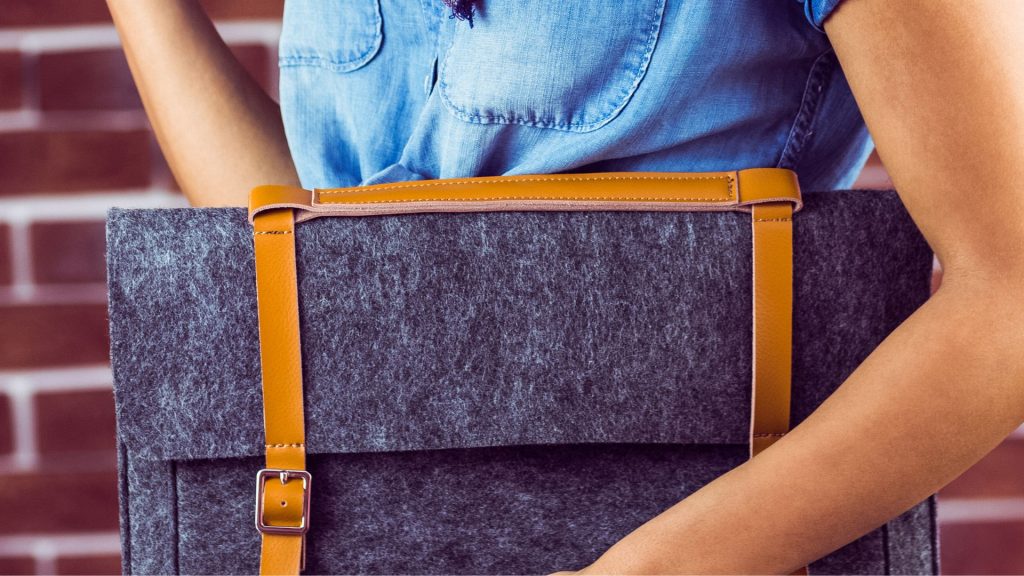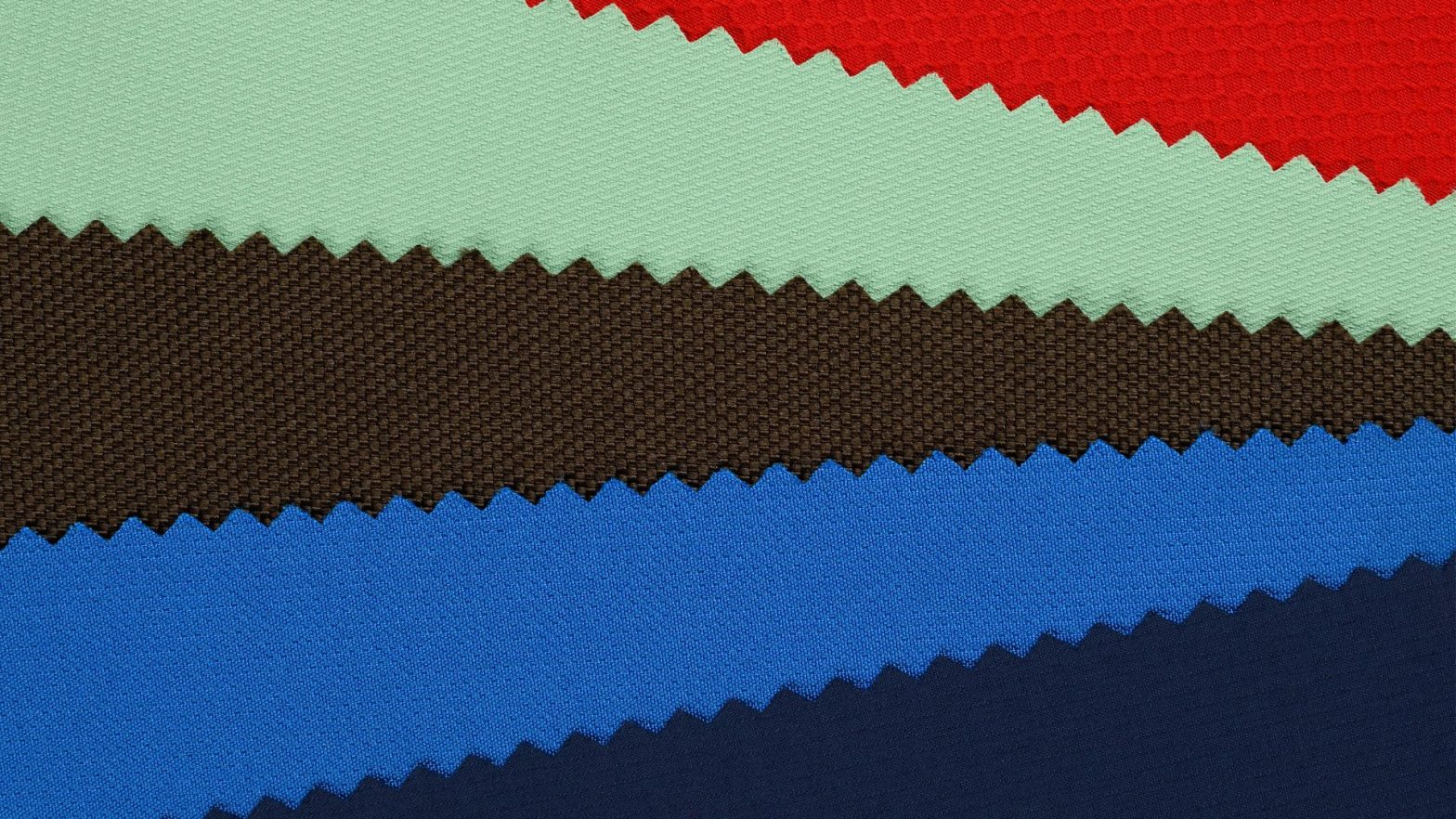Choosing your bags fabrics is a big decision. Not only do you need fabric that fits your budget, but it also needs to appeal to your customer base and align with your brand values.
The problem is that there are so many bags fabrics out there, that you may be wondering how in the world you’re ever going to choose the right ones for your new bag line.
To get around this problem, we recommend looking at which bag fabrics brands and manufacturers use the most. This way, you can narrow your search down to the bag fabrics that work best for your designs based on their popularity, attractiveness, durability, budget-friendliness, and other essential factors.
Read on to discover 6 of the most interesting bags fabrics on the market today, what bags they’re used to make, the advantages and disadvantages of using them, and how much they cost.
1. Leather

What is Leather Fabric?
Leather is a fabric made from animal skins that have been tanned. Some common sources of genuine leather material are cow, deer, snake, and alligator. Keeping your budget in mind, a wide range of animal skin options are available.
You’ll find leather most often in handbags, crossbody bags, and backpacks.
Advantages And Disadvantages Of Leather Bags Fabrics
Advantages:
- Durability: Leather is highly durable and an ideal fabric for bags that will see lots of use over the years.
- Abrasion Resistance: When treated and well cared for, leather will remain free of scuffs and scratches.
- Fire Resistance: If treated, leather is resistant to fire.
- Water Resistance: Leather wicks away water and remain unscathed by moisture – provided it’s treated.
- Flexibility: Leather is flexible and malleable to a mold, making it an excellent material for a structured bag.
- Longevity: Leather will last many years as long as it’s taken care of.
Disadvantages:
- High Cost: Leather is by far one of the most expensive bag fabrics. This disadvantage can deter companies from using leather altogether.
- Not Vegan Friendly: If your customer base is primarily vegan or environmentally conscious, then leather fabric may not be a great choice for your bag line.
How Much Does Leather Cost?
Genuine top-grain leather is extremely costly, which is why there are several types of faux leather – like recycled PVB leather – on the market.
Read more about Using Leather In Bag Manufacturing.
2. Polyester
What Is Polyester?
Polyester is another type of thermoplastic derived from petroleum. The process of making polyester fabric begins with melting down ethylene glycol from the petroleum along with purified terephthalic. Together, these two substances are from polyethylene terephthalate (PET), from which polyester manufacturers form fibers and weave them together into a fabric. See also Recycled Polyester.
You’ll often find polyester in backpacks and duffel bags.
Advantages And Disadvantages Of Polyester Bags Fabrics
Advantages:
- Elasticity: Polyester is an elastic material that has some stretch, yet still retains its shape.
- Durability: Polyester fabric is strong, which is why it’s so popular in backpacks and duffel bags. You can rough it with a bag made of this material and it will hold up.
- Moisture Resistance: Like nylon, polyester wicks away moisture and dries quickly.
- Texture Variety: Polyester is available in a wide variety of textures, from coarse to smooth like satin.
- Drapability: Polyester is easy to shape and will keep that shape.
Disadvantages:
- Breathability: Similar to nylon, polyester fibers are constructed closely together. This reduces the material’s breathability, so anything kept inside a polyester bag is at risk of becoming too hot or humid if it’s exposed to a hot or humid environment.
- Flammability: Polyester is flammable, which means that polyester bag owners should take extra caution to make sure they never put their bag close to a fire.
- Environment-killer: Processing virgin polyester has a tremendous negative effect on the planet.
How Much Does Polyester Cost?
Polyester is a low-cost option for bags fabrics, cheaper even than nylon.
Read more about Using Polyester In Bag Manufacturing.
3. Nylon
What is Nylon Fabric?
Nylon is a type of thermoplastic that is usually sourced from petroleum. It is melted down and processed into fibers, and those fibers make up the fabric that we use for several different bag types, especially backpacks and duffel bags.
Advantages And Disadvantages Of Nylon Bags Fabrics
Advantages:
- Elasticity: Nylon is somewhat elastic, and elasticity is always a great quality in material for a backpack or duffel bag. In bag form, it allows the fabric to stretch and bulge outward to accommodate a large number of objects, even if the objects are oddly shaped. Yet at the end of the day, it will still retain its original shape.
- Durability: Nylon is a sturdy fabric that will last a long time without wearing out. Consumers get their money’s worth in terms of long use when they buy a bag made of nylon fabric.
- Clean: Nylon is easy to keep clean. It doesn’t cling to dirt or other grime, so if a nylon bag gets dirty, you can just wipe it clean with a wet cloth. You can also wash nylon fabric in cold water, and it won’t lose its shape.
- Moisture Resistance: Nylon repels water for the most part, and if any part of it absorbs water, it will dry quickly. This makes it a smart bag fabric choice for people who are often outside or frequently visit places where they are likely to get wet, like a pool or a beach.
- Drapability: Nylon drapes well, meaning it can be molded to the manufacturer or brand’s desired shape.
Disadvantages:
- Breathability: One of the substances that make up nylon is closed construction filaments. These are tightly packed filaments of plastic that trap heat inside the fabric. This can be a problem during hot weather if you want to use the nylon bag to carry perishable food or electronics that could overheat.
How Much Does Nylon Fabric Cost?
Nylon is inexpensive. Factoring its cost into all its pros, with a small list of cons, It’s definitely a cost-effective choice if you can’t afford cotton, canvas, or other natural bags fabrics.
Read more about Using Nylon In Bag Manufacturing.
4. Canvas

What is Canvas?
Canvas is a type of woven fabric that is made from cotton or linen fibers. It can also be made with polyvinyl chloride (PVC). Provided it’s made from cotton or linen or another natural source, like hemp, it’s considered a natural fabric. Canvas is a common material for backpacks, duffel bags, and totes, due to its many advantages as a bag fabric.
Advantages And Disadvantages Of Canvas Bags Fabrics
Advantages:
- Durability: Canvas is a highly durable and sturdy material. A canvas that has been treated with chemicals will last a long time without wearing out. This makes it a great material for a bag that will get a lot of use and carry around heavy objects.
- Washability: Canvas is washable and easy to clean.
- Color Printing: The natural off-white color of canvas is, frankly, a great canvas. It holds color printing well, so brands can easily customize bags made of this material.
Disadvantages:
- Weight: Canvas is a heavy fabric, especially when it gets humid/wet. This can be a problem if you’re carrying the bag outside where it could get rained on or splashed with puddle water.
How Much Does Canvas Cost?
Canvas is more expensive than nylon or polyester because it’s made from a natural source, and is not synthetic. It is, however, one of the cheaper natural fabrics.
5. Felt

What is Felt Fabric?
Felt is a soft, but dense fabric made from natural fibers, typically wool.
There are a few different methods of creating felt, but the most popular type for bags – woven felt – is made by weaving strands of wool into cloth, and then compressing the cloth while it is exposed to moisture. The compression along with the moisture causes the fibers to interlock and form a closely connected unit.
Felt is most often used in handbags, crossbody bags, and backpacks. It can be used as the main fabric, or as internal reinforcement.
Advantages And Disadvantages Of Felt Bags Fabrics
Advantages:
- Durability: Thanks to the strength and resiliency of its interlocking wool fibers, felt is quite durable. It will stand up to a lot of wear and tear, which is important for a bag.
- Availability: Felt is available in many different colors and various thicknesses, so companies will not feel limited by their choices in this fabric.
- Lightness: Even though felt feels warm, it’s incredibly lightweight. This is another quality that makes it a great material for a bag, which should be designed to be carried around for long periods of time.
Disadvantages:
- Elasticity: Felt doesn’t have much stretch or give to it.
- Shrinkage: Felt is liable to shrink if it’s not washed properly.
How Much Does Felt Cost?
Felt is low cost, especially for a material made with natural fibers.
6. Recycled PVB Leather
What is Recycled PVB Leather Fabric?
Recycled PVB leather is a new type of synthetic leather that is not made using animal hides, but rather a material called polyvinyl butyral (PVB). PVB is used primarily as a resin in vehicle windshields and windows. It strengthens the glass and protects it during accidents. However, it’s difficult to reuse in windshields, so some fabric manufacturers started recycling it into faux leather.
Advantages And Disadvantages Of Recycled PVB Leather Bags Fabrics
Advantages:
- Elasticity: Recycled PVB leather is highly elastic. It can be molded into a particular shape for a bag, and it will continue to keep that shape throughout its lifetime.
- Abrasion Resistance: Like real leather, recycled PVB leather is resistant to abrasions. This prevents it from looking scuffed and scratched, and therefore cheap over time.
- Water Resistance: Recycled PVB leather does not absorb moisture, rather it wicks water and liquid droplets away from its surface.
- Fading Resistance: The color of recycled PVB leather doesn’t easily or quickly fade.
- Sustainability: The process used to synthesize recycled PVB is better for the environment and more sustainable. During the manufacturing process, the factory recycles existing material and transforms it into usable material with a smaller carbon footprint than real leather.
Disadvantages:
- Durability: Recycled PVB leather is not quite as durable as the real kind. However, it’s close enough that it’s still a comparable material. It’s also a great deal stronger and more long-lasting than other faux leathers.
How Much Does Recycled PVB Leather Cost?
Recycled PVB leather is slightly cheaper than real leather, but it’s still a high-quality material. It is a perfect vegan leather option for companies to get the look and feel of genuine material.
Conclusion
There are a lot of fantastic fabric choices for your bag line out there. Most companies, though, gravitate toward inexpensive but durable materials.
Recycled PVB leather, felt, nylon, polyester, and canvas are all affordable, attractive fabrics, and their advantages make them ideal bag materials. Alternatively, if you have the budget for it, real leather is a great option that will add timeless luxury and durability to your bag line.
